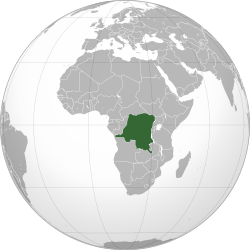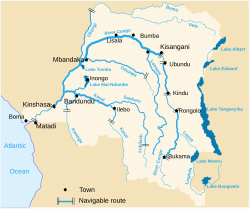
Back Адемократиатә Республика Конго Abkhazian Republik Demokratik Kongo ACE Demokratiese Republiek die Kongo Afrikaans Demokratische Republik Kongo ALS ኮንጎ ዲሞክራሲያዊ ሪፐብሊክ Amharic Congo, democratic republic of the AMI Republica Democratica d'o Congo AN Folcrīcelicu Cynewīse þæs Congwes ANG Kongo Kinshasa ANN कॉन्गो ANP
Democratic Republic of the Congo République démocratique du Congo (French) Repubilika ya Kôngo ya Dimokalasi (Kongo) Republíki ya Kongó Demokratíki (Lingala) Jamhuri ya Kidemokrasia ya Kongo (Swahili) Ditunga dia Kongu wa Mungalaata (Luba-Katanga) | |
|---|---|
| Motto: "Justice – Paix – Travail" (French) "Justice – Peace – Work" | |
| Anthem: Debout Congolais (French) "Arise, Congolese" | |
 Location of Democratic Republic of the Congo (dark green) | |
| Capital and largest city | Kinshasa 4°19′S 15°19′E / 4.317°S 15.317°E |
| Official languages | French & Swahili |
| Recognised national languages | Lingala Kikongo Tshiluba |
| Ethnic groups | See Ethnic groups section below |
| Demonym(s) | Congolese |
| Government | Unitary semi-presidential republic |
| Félix Tshisekedi | |
| Judith Suminwa Tuluka | |
| Legislature | Parliament |
| Senate | |
| National Assembly | |
| Formation | |
| 17 November 1879 | |
| 1 July 1885 | |
| 15 November 1908 | |
• Independence from Belgium | 30 June 1960[1] |
| 20 September 1960 | |
• Renamed to Democratic Republic of Congo | 1 August 1964 |
| 29 October 1971 | |
| 17 May 1997 | |
| 18 February 2006 | |
| Area | |
• Total | 2,345,409 km2 (905,567 sq mi) (11th) |
• Water (%) | 3.32 |
| Population | |
• 2021 estimate | 95,894,118[2][3] (16th) |
• Density | 34.83/km2 (90.2/sq mi) |
| GDP (PPP) | 2017 estimate |
• Total | $67.988 billion[4] |
• Per capita | $785[4] |
| GDP (nominal) | 2017 estimate |
• Total | $40.415 billion[4] |
• Per capita | $446[4] |
| Gini (2006) | medium |
| HDI (2018) | low · 176th |
| Currency | Congolese franc (CDF) |
| Time zone | UTC+1 to +2 (WAT and CAT) |
| Driving side | right |
| Calling code | +243 |
| ISO 3166 code | CD |
| Internet TLD | .cd |

The Democratic Republic of the Congo (French: République démocratique du Congo), commonly referred to as DR Congo, Congo-Kinshasa or the DRC, is a country in central Africa. It was known as Zaïre from 1971 to 1997. It is the second largest country in Africa by area and the eleventh largest in the world. With a population of over 71 million,[1] the Democratic Republic of the Congo is the nineteenth most populous nation in the world, the fourth most populous nation in Africa, as well as the most populous Francophone (French-speaking) country.
DRC borders the Central African Republic and South Sudan to the north; Uganda, Rwanda, and Burundi in the east; Zambia and Angola to the south; the Republic of the Congo, the Angolan exclave of Cabinda, and the Atlantic Ocean to the west. It is separated from Tanzania by Lake Tanganyika in the east.[1] The country has access to the ocean through a 40-kilometre (25 mi) stretch of Atlantic coastline at Muanda and the roughly 9 km wide mouth of the Congo River which opens into the Gulf of Guinea. It has the second-highest total Christian population in Africa.
- ↑ 1.0 1.1 1.2 Central Intelligence Agency (2014). "Democratic Republic of Congo". The World Factbook. Langley, Virginia: Central Intelligence Agency. Archived from the original on 18 May 2020. Retrieved 20 March 2020.
- ↑ "World Population Prospects 2022". population.un.org. United Nations Department of Economic and Social Affairs, Population Division. Retrieved July 17, 2022.
- ↑ "World Population Prospects 2022: Demographic indicators by region, subregion and country, annually for 1950-2100" (XSLX). population.un.org ("Total Population, as of 1 July (thousands)"). United Nations Department of Economic and Social Affairs, Population Division. Retrieved July 17, 2022.
- ↑ 4.0 4.1 4.2 4.3 "Democratic Republic of the Congo". International Monetary Fund.
- ↑ "GINI index". World Bank. Retrieved 30 July 2013.
- ↑ "2018 Human Development Report". United Nations Development Programme. 2018. Archived from the original on 14 September 2018. Retrieved 14 September 2018.

